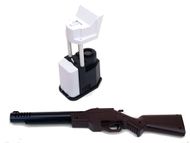Beam Gun

| |
| Beam Gun | |
| Developer | Nintendo R&D1 |
|---|---|
| Publisher | Nintendo |
| Systems | Beam Gun SP, Beam Gun Custom Toys, self contained Beam Gun Series Gun Nintendo Family Computer |
| Released | Beam Gun SP, Beam Gun Custom JP: 1970-1976 Beam Gun Series Gun JP: February 18, 1984 |
| Added to Museum | Duck Hunt: December 18, 2017 |
Beam Gun (光線銃) was a toy line by Nintendo, which utilized a light gun designed by Masayuki Uemura.
The object of each of the games is to line the gun up to fire light at physical targets.
Nintendo's first game development group, Nintendo Research & Development 1, was formed in 1970 to develop the Beam Gun series of toys.
Beam Gun toys
Beam Gun SP (光線銃SP) was the first line of light gun toys by Nintendo. The toys were created in 1970 after Masayuki Uemura joined Nintendo from Sharp Corporation. He assisted Nintendo toy designer Gunpei Yokoi with solar cell engineering to use in his Beam Gun toys. The guns would be aimed at a physical target. The target would have a flash that would be detected by the light gun, which would report it as a hit. It was capable of firing at a distance of up to 24 feet.
Bean Gun Custon (光線銃 カスツム) was the improved line of light gun toys by Nintendo. Whereas the Beam Gun SP was capable of firing at a distance of up to 24 feet, the Beam Gun Custom could fire at a distance of up to 300 feet. First released to the public in 1976, it wasn't as popular as its predecessor, and ultimately only three toys in the Beam Gun Custom line were released.
From toy to arcade game
In 1971, Nintendo president Hiroshi Yamauchi wanted to expand their lightgun toys into a shooting range simulation. He asked Gunpei Yokoi to create a simulation based on clay pigeon shooting.
Hiroshi Yamauchi intended for these shooting range simulations to be installed in vacant bowling alleys. After Americans brought bowling to Japan after they continued to live there after World War II, bowling became a popular Japanese pastime. The Japanese bowling fad was short-lived however, as by the 1970s, many bowling alleys were sitting abandoned. Nintendo purchased several of these bowling alleys with the intention to convert them into electronic shooting ranges. Gunpei Yokoi and Masayuki Uemura, together with Genyo Takeda, created a shooting gallery game to use in Nintendo's converted bowling alleys.
The result was the Laser Clay Shooting System, which consisted of a screen, with a film of clay pigeons broadcast on it over an overhead projector. In front was the light gun, which when fired, a network of reflective surfaces would register whether the shot was a hit or a miss. The game was unveiled in 1973, however its first demonstration didn't work properly. Yokoi had to stand behind the screen, adding the score to the system manually. After its unveiling, the bug in the program was fixed, and the game worked perfectly for the rest of the time it was in operation.
Simulation System
After the 1973 Oil Crisis, Nintendo had to abandon its grand plans to use Japan's bowling alleys as electronic shooting ranges. They reduced the size of the system so that it could be sold as an arcade game. The Laser Clay Shooting System was adapted for the smaller setup and was sold to arcades as Mini Laser Clay. Sales for Nintendo's Simulation System started off slowly, but they gradually increased in volume, which led to Nintendo adapting the system for use with other films. The additional games were Wild Gunman in 1974, Shooting Trainer and Sky Hawk in 1976, and Battle Shark in 1977, and New Shooting Trainer and Test Driver in 1978.
From arcade game to home
In 1976, Beam Gun: Duck Hunt was released. It used a simplified projector compared to the Simulation System. It was contained in a compact setup, as it was intended for home use.
On February 18, 1984, a light gun accessory was released for the Nintendo Family Computer in Japan. As an homage to its legacy, the light gun was sold in Japan as the Beam Gun Series Gun (光線銃シリーズ ガン). When it was remodeled for foreign markets the next year, it became known as the Zapper.
